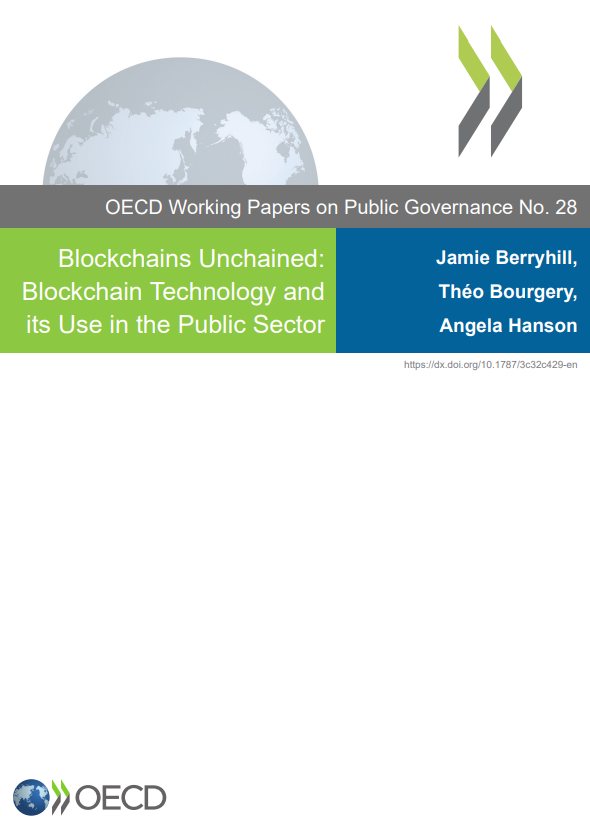Blockchains Unchained: Blockchain technology and its use in the public sector

Overview
This guide aims to equip public servants with the necessary knowledge to understand what the Blockchain architecture is, the implications it could have on government services, and the opportunities and challenges governments may face as a result. This paper also aims to provide information on what Blockchain technology is not, and areas where its application may not be useful. It is often the case that hype around the impact of emerging and disruptive technologies overstates their practical and pragmatic applications. An understanding of what Blockchain technology is and is not is critical in helping policy makers and civil servants look past the hype and determine whether Blockchain technology is something that may help them advance their missions.
Blockchains have become a buzz word, yet ambiguity remains around what they truly are. Their impact on the public sector is at best misunderstood, and most often ignored. The technical complexity of Blockchain technology skews public debate, as the topic can be difficult to discuss and explore for potential application in government. In addition, despite having a wide range of potential uses in many areas of government, Blockchain technology is often incorrectly seen as synonymous with Bitcoin and the “dark web” markets that use Bitcoin as the primary payment method for illicit goods. Blockchain introduces the possibility to manage information and trust in completely new ways that need to be understood in order for the public sector to seize the new opportunities that they present.
Current transactional processes predominantly involve institutions such as governments or banks that act as trusted, central third-parties to certify transactions, which potentially position them as single points of failure in the event of a disaster, attack, or other sort of disruption, which raises questions about the continuity of the services they provide and records they keep. Blockchains may help address some of government’s existing challenges in this space. Blockchain technology may also help governments reduce fraud, errors, and the cost of paper-intensive processes (ACT-IAC, 2017), and by design can provide perfect transparency over government data and transactions.
What are blockchains?
Section I defines Blockchain technology as a digital distributed ledger system that acts as an open, shared and trusted record of transactions among parties that is not stored by a central authority, which has and continues to be the traditional approach. Instead, all users running Blockchain software—also known as nodes—have a copy. This way, everyone can inspect it (OECD, 2016). Blockchain technology’s underpinning assumption is that all transactions will be visible to all nodes in the system at all times. To achieve this, in general, all nodes hold identical ‘ledgers’ of transactions that are rapidly updated any time a new set of transactions is added. This enables a key feature of the Blockchain architecture: consensus models where nodes in the system confirm the validity of transactions that occur on the platform, and flag inappropriate dealings when necessary.
The next stage involves ensuring transaction are tamper-proof. One must imagine a Blockchain as, quite literally, a chain of blocks in which specific transactions are stored. Once transactions are validated by nodes, they are stored in blocks which cryptography and complex mathematical constructions secure. Each individual block is published to the Blockchain in a way that it is linked to the previous block, and will also be connected to the next block once it is added to the chain. Due to its linear, chain-like architecture, blocks are fundamentally dependent on one another, such that changing the information of one ultimately alters the link it has with all other blocks on the chain in a way that can be immediately recognised by the other nodes as have being altered. The chained structure, coupled with consensus rules that require that a majority of nodes agree on the validity of the ledger, ensure that the information contained in the ledger cannot be tampered with. Thus, transactions can be inherently trusted.

BenBen
BenBen provides an Ethereum-run digital register system of all land registries across Ghana. It is able to certify land information through a combination of satellite imagery and on-the-ground verifications, working hand-in-hand with local stakeholders in the land market. It aggregates all the information in a way that financial institutions and the Lands Commission have real-time access to the data.
BenBen acts as a risk-mitigation tool to financial institutions, governments and property owners during the entire land transaction process. The use of digitised and incorruptible ledgers on land ownership records and land titles in Ghana has also led to the User Committee of the Commercial Courts in Ghana to explore the use case of BenBen as an expert witness in land related commercial disputes.
It provides instant, reliable and untampered-with information to determine the legality of a claim on land ownership.
???????? Ghana
Interestingly, Blockchain technology suggests that banks and governments could no longer be required as trusted third-parties, at least not in the same capacity as they are today. This is the real disruptive nature and potential value of Blockchains: the development and growth of automated and decentralised decision-making systems that do not require centralised authorities yet still ensure validity and transparency.
Section I also discusses the various ways governments have begun to react and adapt to the emergence of Blockchain technology. This includes discussing the landscape of current Blockchain initiatives, as well of the various types of use cases that may the most relevant in the public sector.

Project Ubin
The Monetary Authority of Singapore (MAS) partnered with R3 – a consortium of banks and regulators specialised in digital ledger technologies – to develop and apply a blockchain-based transaction process with a digital Singaporean dollar. This would not only allow incorruptibility through a decentralised trust system, but it would allow transactions to run 24 hours a day with no centralised – i.e. human-based – checks required. It invited a number of different banks – the main beneficiaries – to participate in the early development and trials of the technology.
By the end of Phase 1, Project Ubin demonstrated that a working interbank transfer prototype on a private Ethereum network was successfully built, and a Smart Contract codebase developed. More importantly, it managed to fully integrate existing technologies on digital transactions with a rather new Blockchain technology.
???????? Singapore
Challenges, limitations and other consideration of Blockchain technologies in government
Section II focuses on the challenges that Blockchain technology poses to public administrations, as well as its limitations which may make render the technology unsuitable for certain uses. These take many shapes and forms, be it matters of data protection, governance, or confidentiality of information. Coding constraints and governance decisions also add to the complexity. In addition, the key aspect of Blockchain technologies—immutability—makes the technology less useful than other proven technologies for many uses. Finally, In addition, the format that some Blockchains take today have inherent limitations, such outrageously high levels of energy required to power the certain Blockchain systems, as well as the slow pace of transactions processes in some systems. However, many limitations are simply used a blockers for further exploration of Blockchain and are not in fact relevant to public sector applications at all. These challenges, limitations, and consideration must be understood by leaders and public servants as Blockchains continue to expand out of the private sphere into the public sector.
Finally, a series of appendices provide case studies as well as some more technical discussions of specific aspects of Blockchain technology. Appendix A, in particular, provides the reader with a number of different case studies of Blockchain uses and communities in the public sector – from across the world, and across a variety of departments and agencies. While Blockchain technologies have mostly been used in the financial sector, predominantly for monetary transactions, this powerful technology is also being used for non-monetary matters. Digital identification, proof of land ownership, supply chain management, and even voting, are only a fraction of the disruptive impacts Blockchains could have on the public sector.
The purpose of this guide is to help leaders, public servants, practitioners and decision-makers to understand the technology and its associated opportunities and challenges. This will help them make better decisions and more easily assess the use of Blockchains across different contexts. Although seemingly complex, policy-makers must grasp the technology and its implications, as this trend is already deeply transformative.

Blockchains Unchained: Blockchain technology and its use in the public sector
Published 19 June 2019.
